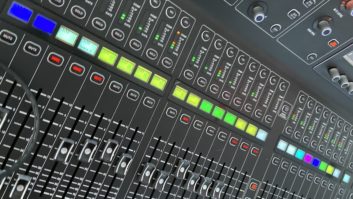February 27, 2019: Tonight I’m working the O2 Institute in Birmingham, England. Originally constructed in the early 1900s as a Methodist congregational chapel, the building was bought by the city of Birmingham in 1955 and used as a civic hall. It later became a live performance venue and has since become an essential part of Birmingham’s music community.
The room is squarish in shape, with the stage in the center at one end and the mix position underneath the balcony at the opposite end. The U-shaped balcony runs around three sides of the room, and is reminiscent of what you might expect to see in a small opera house. Capacity of the venue is around 1,500.

What’s a bit unusual is that the balcony is rather low. When you’re standing underneath it, the floor to ceiling height is around nine feet. You could probably jump up and touch the underside of the balcony with your fingertips. It slopes upward, conforming to the rake of the balcony seating. As a result, the arrangement of the P.A. is rather unconventional.
A ground-stacked system covers the main floor, consisting of six Turbosound Aspect TA880H mid-high enclosures (three per side), eight Turbosound TSW218 subwoofers (four per side), and two d&b Audiotechnik E9s for front fill. The height of this system never reaches past the underside of the balcony and serves to cover only the floor.
Read more Mix Blog Live: Follow That Plow!
A second P.A. system consisting of ten Turbosound TFA600H Flex Array cabinets is flown five per side. The TFA600Hs are arrayed so that a minimum of direct sound from them reaches the patrons on the floor. This—coupled with the wide horizontal by narrow vertical coverage of the ground P.A.—almost creates separate zones within the room. You can hear the ground P.A. when you’re in the balcony, and you can hear the flown P.A. from the floor, though not nearly as much as you might expect.
Tuning the flown system proved the biggest challenge, as it required running upstairs, listening, coming back down, adjusting the array EQ, then running back up to hear the results. Where’s that iPad for system control??!! After a few trips up and down (throughout which “running” turned into “plodding”), the house tech Jack and I had the flown portion of the system dialed in nicely, notching out some of the low-mids around 250, 315 and 400 Hz to maintain clarity.
Meanwhile the downstairs system was rocking away, with little to no need for EQ at soundcheck. During the show we tweaked a bit in the region of 2.5 kHz to keep the horns from getting harsh. We also had some issues with feedback from the vocal mics around 160 Hz. Looking back, I would have pulled the front line of microphones upstage a few feet to minimize this issue because the feedback was caused by wraparound from the ground-stacked system reaching the vocal microphones.
All in all, the two concurrent systems worked out surprisingly well. Now if we could only reduce the room’s natural reverb time….







